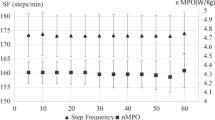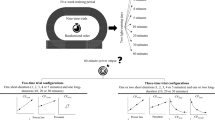Abstract
The work capacity over critical power is theoretically defined by the curvature constant. However, this parameter has been characterized by a large standard error of the estimate. Therefore, this study aims to determine the validity of this parameter to represent the work performed over critical power on different time trials along the severe intensity domain. Athletes performed four-time trials (3, 5, 10 and 20 min) in a two-week training period on a 400-meter outdoor track. The mean power output of each time trial was measured through the Stryd power meter, and the inverse of the time model was used. The work depletion was modelled in each time trial until exhaustion. The standard error of the estimate was 2.4 (1.0) % for critical power and 12.3 (4.3) % for work over it. Although no significant differences were reported between the work estimated by the critical power model and the one performed on each time trial (P ≥ 0.058), the 95% confidence intervals revealed potential significant discrepancies at the 10-min (−1.4 [−3.1 to 0.3] kJ) and 20-min (2.2 [−0.1 to 4.6] kJ) time trials, respectively. If the work estimated by the critical power model were used, subjects would have reached exhaustion at −8.0 [−19.4 to 3.3] % for the 10-min time trial, and at 13.3 [−2.8 to 29.5] % for the 20-min time trial. Thus, athletes and practitioners are encouraged to consider the specific work of the duration of interest at the severe intensity domain when monitoring with power in running.


Similar content being viewed by others
Data availability
Data is accessible upon reasonable request from the corresponding author.
References
Burnley M, Jones AM (2018) Power–duration relationship: Physiology, fatigue, and the limits of human performance. Eur J Sport Sci 18(1):1–12
Goulding RP, Marwood S (2023) Interaction of factors determining critical power. Sports Med 53(3):595–613
Ruiz-Alias SA, Ñancupil-Andrade AA, Pérez-Castilla A, García-Pinillos F (2023) Running critical power: a comparison of different theoretical models. Int J Sports Med 44(13):969–975
Kirby BS, Winn BJ, Wilkins BW, Jones AM (2021) Interaction of exercise bioenergetics with pacing behavior predicts track distance running performance. J Appl Physiol 131(5):1532–1542
Skiba PF, Clarke DC (2021) The W′ balance model: Mathematical and methodological considerations. Int J Sports Physiol Perform 16(11):1561–1572
Jones AM, Vanhatalo A (2017) The ‘critical power’concept: applications to sports performance with a focus on intermittent high-intensity exercise. Sports Med 47:65–78
Housh TJ, Cramer JT, Bull AJ, Johnson GO, Housh DJ (2001) The effect of mathematical modeling on critical velocity. Eur J Appl Physiol 84(5):469–475
Triska C, Karsten B, Nimmerichter A, Tschan H (2017) Iso-duration determination of D′ and CS under laboratory and field conditions. Int J Sports Med 38(07):527–533
Black MI, Jones AM, Blackwell JR, Bailey SJ, Wylie LJ, McDonagh ST et al (2017) Muscle metabolic and neuromuscular determinants of fatigue during cycling in different exercise intensity domains. J Appl Physiol 122(3):446–459
Black MI, Jones AM, Bailey SJ, Vanhatalo A (2015) Self-pacing increases critical power and improves performance during severe-intensity exercise. Appl Physiol Nutr Metabolism 40(7):662–670
Liversedge M (2023) GoldenCheetah. https://www.goldencheetah.org/
TrainingPeaks (2024) WKO software. https://www.trainingpeaks.com/wko5/
Chorley A, Lamb KL (2020) The application of critical power, the work capacity above critical power (W′), and its reconstitution: a narrative review of current evidence and implications for cycling training prescription. Sports 8(9):123
di Prampero PE (1999) The concept of critical velocity: a brief analysis. Eur J Appl Physiol Occup Physiol 80:162–164
Ruiz-Alias SA, Ñancupil-Andrade AA, Pérez-Castilla A, García-Pinillos F (2023) Running critical power and W’: influence of the environment, timing and time trial order. Int J Sports Med. https://doi.org/10.1055/a-2201-7081
Cerezuela-Espejo V, Hernández-Belmonte A, Courel-Ibáñez J, Conesa-Ros E, Mora-Rodríguez R, Pallarés JG (2021) Are we ready to measure running power? Repeatability and concurrent validity of five commercial technologies. Eur J Sport Sci 21(3):341–350
Ruiz-Alias SA, Olaya-Cuartero J, Ñancupil-Andrade AA, García-Pinillos F (2022) 9/3-minute running critical power test: mechanical threshold location with respect to ventilatory thresholds and maximum oxygen uptake. Int J Sports Physiol Perform 17(7):1111–1118
Imbach F, Candau R, Chailan R, Perrey S (2020) Validity of the Stryd power meter in measuring running parameters at submaximal speeds. Sports 8(7):103
Taboga P, Giovanelli N, Spinazzè E, Cuzzolin F, Fedele G, Zanuso S, Lazzer S (2022) Running power: lab based vs. portable devices measurements and its relationship with aerobic power. Eur J Sport Sci 22(10):1555–1568
Whipp B, Huntsman DSTA et al (1982) A constant which determines the duration of tolerance to high-intensity work. Fed Am Soc Exp Biol 41:1591
Hill DW, Smith JC (1994) A method to ensure the accuracy of estimates of anaerobic capacity derived using the critical power concept. J Sports Med Phys Fitness 34(1):23–37
Spencer MR, Gastin PB (2001) Energy system contribution during 200-to 1500-m running in highly trained athletes. Med Sci Sports Exerc 33(1):157–162
Jones AM, Grassi B, Christensen PM, Krustrup P, Bangsbo J, Poole DC (2011) Slow component of VO2 kinetics: mechanistic bases and practical applications. Med Sci Sports Exerc 43(11):2046–62
Triska C, Karsten B, Beedie C, Koller-Zeisler B, Nimmerichter A, Tschan H (2018) Different durations within the method of best practice affect the parameters of the speed–duration relationship. Eur J Sport Sci 18(3):332–340
Maturana FM, Fontana FY, Pogliaghi S, Passfield L, Murias JM (2018) Critical power: how different protocols and models affect its determination. J Sci Med Sport 21(7):742–747
Burnley M, Jones AM (2007) Oxygen uptake kinetics as a determinant of sports performance. Eur J Sport Sci 7(2):63–79
Bergstrom HC, Housh TJ, Cochrane-Snyman KC, Jenkins ND, Byrd MT, Switalla JR et al (2017) A model for identifying intensity zones above critical velocity. J Strength Cond Res 31(12):3260–3265
Sawyer BJ, Morton RH, Womack CJ, Gaesser GA (2012) V˙ O2max may not be reached during exercise to exhaustion above critical power. Med Sci Sports Exerc 44(8):1533–1538
Billat V, Binsse V, Petit B, Koralsztein JJ (1998) High level runners are able to maintain a VO2 steady-state below VO2max in an all-out run over their critical velocity. Arch Physiol Biochem 106(1):38–45
Ruiz-Alias SA, Ñancupil-Andrade AA, Pérez-Castilla A, García-Pinillos F (2023) Determining critical power and W′ in running: Accuracy of different two-point models using the power metric. Proc Inst Mech Eng Part P J Sports Eng Technol. https://doi.org/10.1177/17543371231200295
Morton RH, Billat V (2000) Maximal endurance time at VO2max. Med Sci Sports Exerc 32:1496–1504
Yoon BK, Kravitz L, Robergs R (2007) VO2max, protocol duration, and the VO2 plateau. Med Sci Sports Exerc 39(7):1186–1192
Hill DW, Poole DC, Smith JC (2002) The relationship between power and the time to achieve VO2max. Med Sci Sports Exerc 34(4):709–714
Galbraith A, Hopker J, Passfield L (2015) Modeling intermittent running from a single-visit field test. Int J Sports Med 36:365–370
Skiba PF, Chidnok W, Vanhatalo A, Jones AM (2012) Modeling the expenditure and reconstitution of work capacity above critical power. Med Sci Sports Exerc 44(8):1526–1532
Ruiz-Alias SA, Ñacupil-Andrade A, Pérez-Castilla A, García-Pinillos F (2024) Running critical power: between-day, interlimb and interunit reliability. Sports Eng 27:10
Acknowledgments
The authors would like to thank all participants.
Funding
Ministerio de Universidades, FPU19/00542, Santiago Alejo Ruiz Ruiz Alias, Ministerio de Ciencia e Innovación (Grant number: MCIN/AEI/10.13039/501100011033).
Author information
Authors and Affiliations
Corresponding author
Ethics declarations
Conflict of interest
The authors declare no conflict of interest.
Additional information
Publisher's Note
Springer Nature remains neutral with regard to jurisdictional claims in published maps and institutional affiliations.
Rights and permissions
Springer Nature or its licensor (e.g. a society or other partner) holds exclusive rights to this article under a publishing agreement with the author(s) or other rightsholder(s); author self-archiving of the accepted manuscript version of this article is solely governed by the terms of such publishing agreement and applicable law.
About this article
Cite this article
Ruiz-Alias, S.A., Ñancupil-Andrade, A.A., Pérez-Castilla, A. et al. Running work capacity over critical power: a variable rather than a constant parameter. Sports Eng 27, 11 (2024). https://doi.org/10.1007/s12283-024-00454-8
Accepted:
Published:
DOI: https://doi.org/10.1007/s12283-024-00454-8




